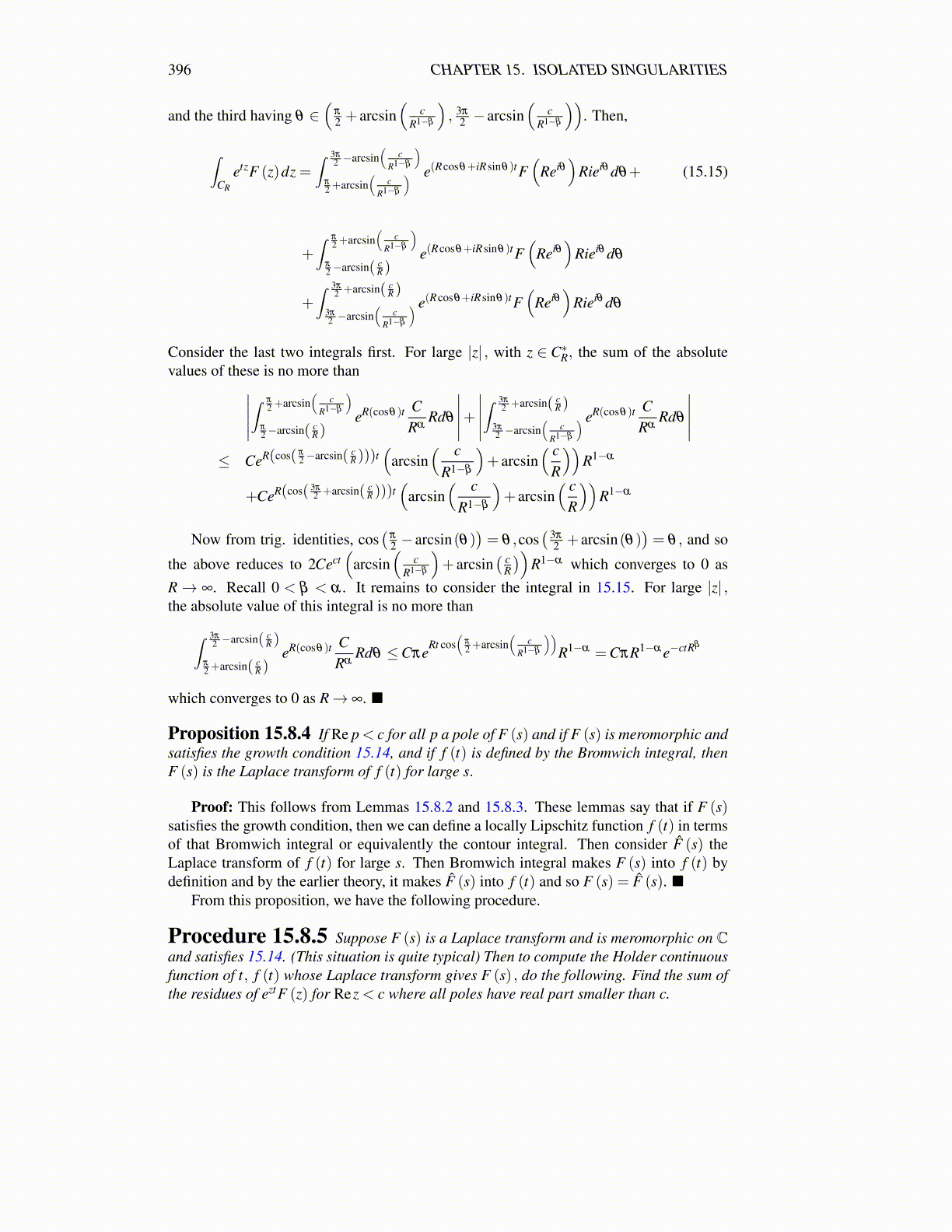
396 CHAPTER 15. ISOLATED SINGULARITIES
and the third having θ ∈(
π
2 + arcsin(
cR1−β
), 3π
2 − arcsin(
cR1−β
)). Then,
∫CR
etzF (z)dz =∫ 3π
2 −arcsin(
cR1−β
)π2 +arcsin
(c
R1−β
) e(Rcosθ+iRsinθ)tF(
Reiθ)
Rieiθ dθ+ (15.15)
+∫ π
2 +arcsin(
cR1−β
)π2−arcsin( c
R )e(Rcosθ+iRsinθ)tF
(Reiθ
)Rieiθ dθ
+∫ 3π
2 +arcsin( cR )
3π2 −arcsin
(c
R1−β
) e(Rcosθ+iRsinθ)tF(
Reiθ)
Rieiθ dθ
Consider the last two integrals first. For large |z| , with z ∈ C∗R, the sum of the absolutevalues of these is no more than∣∣∣∣∣
∫ π2 +arcsin
(c
R1−β
)π2−arcsin( c
R )eR(cosθ)t C
RαRdθ
∣∣∣∣∣+∣∣∣∣∣∫ 3π
2 +arcsin( cR )
3π2 −arcsin
(c
R1−β
) eR(cosθ)t CRα
Rdθ
∣∣∣∣∣≤ CeR(cos( π
2−arcsin( cR )))t
(arcsin
( cR1−β
)+ arcsin
( cR
))R1−α
+CeR(cos( 3π2 +arcsin( c
R )))t(
arcsin( c
R1−β
)+ arcsin
( cR
))R1−α
Now from trig. identities, cos(
π
2 − arcsin(θ))= θ ,cos
( 3π
2 + arcsin(θ))= θ , and so
the above reduces to 2Cect(
arcsin(
cR1−β
)+ arcsin
( cR
))R1−α which converges to 0 as
R→ ∞. Recall 0 < β < α . It remains to consider the integral in 15.15. For large |z| ,the absolute value of this integral is no more than
∫ 3π2 −arcsin( c
R )
π2 +arcsin( c
R )eR(cosθ)t C
RαRdθ ≤Cπe
Rt cos(
π2 +arcsin
(c
R1−β
))R1−α =CπR1−α e−ctRβ
which converges to 0 as R→ ∞. ■
Proposition 15.8.4 If Re p < c for all p a pole of F (s) and if F (s) is meromorphic andsatisfies the growth condition 15.14, and if f (t) is defined by the Bromwich integral, thenF (s) is the Laplace transform of f (t) for large s.
Proof: This follows from Lemmas 15.8.2 and 15.8.3. These lemmas say that if F (s)satisfies the growth condition, then we can define a locally Lipschitz function f (t) in termsof that Bromwich integral or equivalently the contour integral. Then consider F̂ (s) theLaplace transform of f (t) for large s. Then Bromwich integral makes F (s) into f (t) bydefinition and by the earlier theory, it makes F̂ (s) into f (t) and so F (s) = F̂ (s). ■
From this proposition, we have the following procedure.
Procedure 15.8.5 Suppose F (s) is a Laplace transform and is meromorphic on Cand satisfies 15.14. (This situation is quite typical) Then to compute the Holder continuousfunction of t, f (t) whose Laplace transform gives F (s) , do the following. Find the sum ofthe residues of eztF (z) for Rez < c where all poles have real part smaller than c.